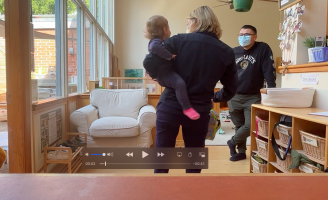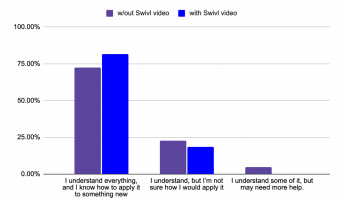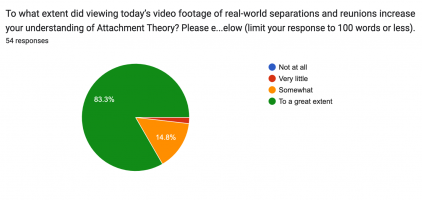Video-based Child Observation Course Integration Initiative IIP
Preliminary Summary
Summer 2022
Intervention
The course instructor integrated video observations of infants, toddlers, and caregivers from the Psychology department’s Megan E. Daly Infant Development Program (IDP) into an undergraduate developmental psychology course, PSYCH 134J: Dynamic Perspectives on Parenting. Real child-caregiver separations and reunions were captured using unobtrusive Swivl video recording technology in the childcare center, and clips were subsequently shown in the course during lessons on Attachment Theory.
The naturalistic observations were designed to demonstrate a fundamental concept in developmental psychology in a novel way and help students learn and engage with the material more deeply.

Assessment
To assess the effectiveness of the intervention, the course instructor Dr. Elisheva Gross and her colleague Dr. Bonnie Goff worked with researchers at the Center for Educational Assessment to develop questions to embed into an exit ticket administered online after each class. Students rated their understanding of each day’s lesson with options differentiating understanding from application to something new, listed the most/least helpful course materials from that day, and described the most important thing learned.
- Rate yourself on your understanding of today’s lesson by checking the box that best describes your learning experience.
- I understand everything, and I know how to apply it to something new.
- I understand, but I’m not sure how I would apply it.
- I understand some of it, but I need more help. (You may explain in the box labelled “Other”).
- Help! I do not understand today’s lesson.
- Other…
[Survey question administered]
On the day the Swivl recordings were shown, students were additionally asked the extent to which the recordings helped their understanding of Attachment Theory with options ranging from ‘Not at all’ to ‘To a great extent’ on a separate page after answering the other questions.
Outcomes
Students were more likely to say they could apply the contents of the lesson from the class with the Swivl video than they were on other days, and 83% of students said the Swivl videos helped them ‘To a great extent.’ Before being asked to explicitly elaborate on their experience with the Swivl videos, 39 of 49 respondents mentioned the videos as being most effective in helping them grasp the main concepts.


Students commented on the how the videos allowed them to see how the theories they were learning played out in the real world.
“[T]he UCLA experiment videos were SO HELPFUL because it was shown as real life examples of what we learned in class in terms of seeing how attachment plays out and the stages being separation anxiety maybe stranger wariness and so on” – PSYCH 134J student
Download the summary here.


